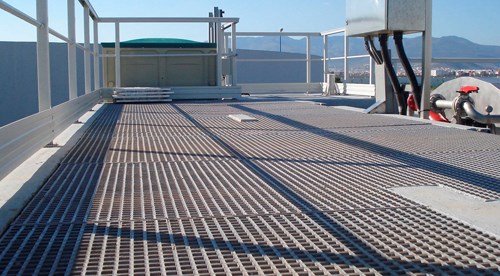ACMA publishes manual for FRP grating
ACMA issues standard for fiberglass grating with an eye for expanding the industrial composites market

The American Composites Manufacturers Association (ACMA, Arlington, VA, US) has published a new manual under the banner of the American National Standards Institute (ANSI, Washington, DC, US). “FRP Composites Grating Manual for Pultruded and Molded Grating and Stair Treads” is intended to educate engineers, designers and end-users about the properties, performance and uses of fiber-reinforced polymer (FRP) grating. Greater knowledge of the performance benefits of FRP will increase awareness of the material and enable engineers to design and use FRP with confidence, says ACMA. FRP grating is used in many industries, from walkways in industrial plants to flooring on ships to decorative grids on commercial and residential buildings. It is more durable and corrosion resistant than steel, which can rust and corrode in extreme environments.
Aldred D’Souza, P.E., the director of engineering/design at Fibergrate Composite Structures Inc. (Dallas, TX, US) and the chair of ACMA’s Fiberglass Grating Manufacturers Council, says, “The successful completion of the FRP Composites Grating Manual marks a major milestone in the advancement of the Industry. This new standard should increase the awareness of FRP grating and its suitability in a wide range of markets beyond wastewater treatment plants, waterparks and chemical plants. As FRP gratings become more mainstream because of this wider acceptance, market expansion for composites is evident.” Other members of the Fiberglass Grating Manufacturers Council who also participated in development of the publication include Strongwell (Bristol, VA, US), Delta Composites LLC (Spring, TX, US), Seasafe Inc. (Lafayette, LA, US), Creative Pultrusions Inc. (Alum Bank, PA, US), Owens Corning (Toledo, OH, US), Interplastic Corp. (St. Paul, MN, US), Precisioneering Ltd. (Scarborough, Ontario, Canada), and ChinaGrate (Nantong, Jiangsu Province, China).
The new publication is not a design manual nor requirement, but a voluntary consensus standard. Approval of an American National Standard requires review by ANSI and assurance that the requirements for due process, consensus and other criteria for approval have been met by the standards developer, in this case, ACMA. Consensus is established when, in the judgment of the ANSI Board of Standards Review, substantial agreement has been reached by “directly and materially affected interests.” The use of American National Standards is completely voluntary; their existence does not in any respect preclude anyone, whether he or she has approved the standard or not, from manufacturing, marketing, purchasing, or using products, processes, or procedures not conforming to the standards, emphasizes ACMA in the standard’s Preface.
The FRP Composites Grating Manual has three sections:
- Load Tables: A quick reference for engineers to compare the performance of FRP grating types under specified load conditions.
- Code of Standard Practice: Representation of generally accepted standard practices in the fiberglass grating industry
- Generic Specification: Suggested guidance for engineers and owners when purchasing composite grating, keeping all grating manufacturers on a level playing field. This specification also promotes manufacturing of gratings that will have minimum performance standards.
The new FRP Composites Grating Manual (print and digital versions) can be found at the ACMA Education Hub. The manual costs $50 for ACMA members and $75 for nonmembers for a hard copy. A digital download (PDF) version costs $40 for members and $60 for nonmembers.
To learn more about ACMA’s Fiberglass Grating Manufacturers Council, contact John Busel at jbusel@acmanet.org.
Related Content
Bladder-assisted compression molding derivative produces complex, autoclave-quality automotive parts
HP Composites’ AirPower technology enables high-rate CFRP roof production with 50% energy savings for the Maserati MC20.
Read MoreFrom the CW Archives: Airbus A400M cargo door
The inaugural CW From the Archives revisits Sara Black’s 2007 story on out-of-autoclave infusion used to fabricate the massive composite upper cargo door for the Airbus A400M military airlifter.
Read MoreInduction heating system enables OOA composites processing
JEC World 2025: Roctool focuses attendees’ attention on the light induction tooling (LIT) system targeting efficiency, sustainability and performance.
Read MoreFlyber launches U.K. composites manufacturing site for advanced mobility applications
The startup’s design automation and composite material layup and curing technologies target lightweighting for aerospace, UAVs, eVTOL and high-performance mobility platforms.
Read MoreRead Next
Cutting 100 pounds, certification time for the X-59 nose cone
Swift Engineering used HyperX software to remove 100 pounds from 38-foot graphite/epoxy cored nose cone for X-59 supersonic aircraft.
Read MoreNext-gen fan blades: Hybrid twin RTM, printed sensors, laser shock disassembly
MORPHO project demonstrates blade with 20% faster RTM cure cycle, uses AI-based monitoring for improved maintenance/life cycle management and proves laser shock disassembly for recycling.
Read MoreScaling up, optimizing the flax fiber composite camper
Greenlander’s Sherpa RV cab, which is largely constructed from flax fiber/bio-epoxy sandwich panels, nears commercial production readiness and next-generation scale-up.
Read More












